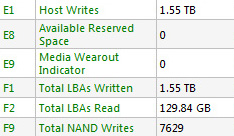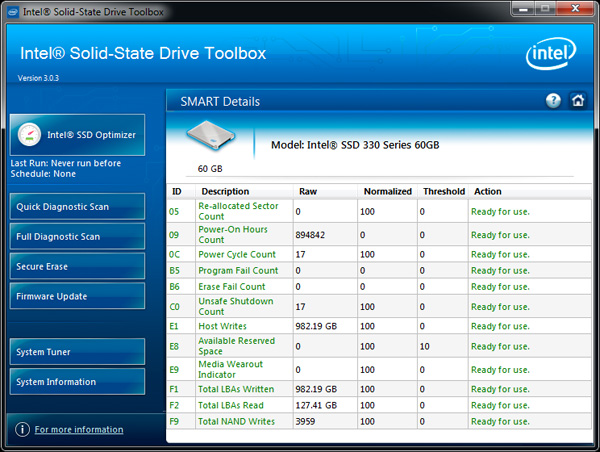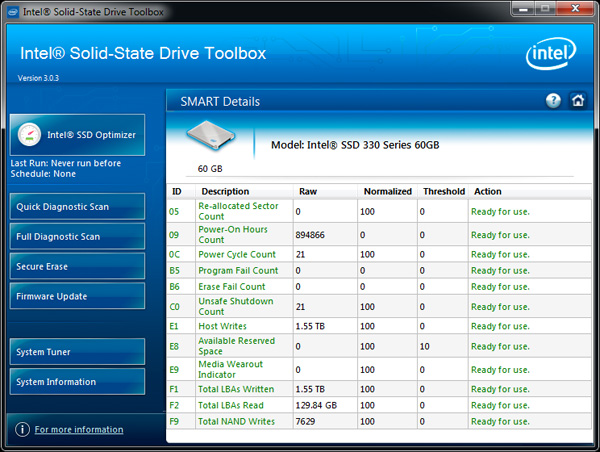The Intel SSD 330 Review (60GB, 120GB, 180GB)
by Anand Lal Shimpi on August 1, 2012 12:01 AM ESTLower Endurance: A Non-Issue
We've mentioned time and time again that NAND endurance is a non-issue for desktop (and even some enterprise) workloads.
Intel doesn't quantify the difference in endurance between the NAND used on the SSD 330 and the 520, it simply states that the 330's NAND will deliver a useful lifespan of 3 years and thus carries a 3 year warranty. Unfortunately, without access to the E2/E3/E4 counters we can't quickly figure out how long the 330 would last given a typical client workload. Thankfully Intel left one SMART wear indicator intact: the E9 attribute, otherwise known as the Media Wearout Indicator.
The normalized value of the E9 attribute (accessible via any SMART monitoring software, or Intel's SSD Toolbox) starts at 100 and decreases, linearly by integer increments, down to 0. Its meaning? The number of cycles the NAND media has undergone. At 100, your NAND is running at roughly full health. At 90, you've exhausted 10% of your NAND's lifespan. By the time the E9/MWI attribute gets down to 1 (99% of NAND p/e cycles have been used up) the counter stops decrementing and you're recommended to replace the drive. Even Intel admits however it's quite likely that at a value of 1 your drive will last for a considerable amount of time.
These are SandForce drives that implement real time data deduplication/compression so I wanted to create the worst case scenario to see how big of a deal this lower endurance NAND would be. I filled the 60GB Intel SSD 330 with incompressible data, leaving only its spare area untouched. I then ran a 4KB random write test, at a queue depth of 32, using incompressible data in four blocks of 6 hours, stopping only to look at the state of the E9/MWI attribute.
Even after 3959GB written to the 60GB drive, the media wear indicator remained at 100. If we do the math and assume that Intel isn't lying about the attribute decreasing linearly from 100 down to 0, it's possible the NAND on this particular 60GB SSD 330 is good for at least 6000 p/e cycles (3959GB/64GB = ~61 p/e cycles per NAND cell).
Not satisfied with these results I went in for another 24 hour round. By the end of it I had written 7629GB to the 60GB drive, at around 119 p/e cycles per NAND cell (assuming perfect wear leveling). The MWI hadn't budged:
Extrapolating based on this data you'd end up with over 10,000 p/e cycles for this particular drive. Whether or not this is accurate remains to be seen, but endurance is clearly not going to be an issue with Intel's SSD 330.
If you assume a typical client drive sees 10GB of writes per day, within a year you'd write 3650GB to the drive. I wrote that much in 24 hours. In fact, I wrote more than two years worth of data to the 60GB Intel SSD 330 in two days. All the while the Intel SSD 330 didn't even blink.
Note that as with any form of binning, you will see examples of drives that do better or worse than the one I've tested. Unless there's something horribly wrong with Intel's 25nm NAND process however, the difference is unlikely to be large enough where it'd be an issue.
As a side benefit to all of this experimenting with death is we can actually quantify write amplification on a SandForce drive.
Intel's 300i firmware, like all SandForce firmware, keeps track of NAND vs. host writes. Using that data I'm able to quantify write amplification during this fairly worst-case scenario workload:

7629GB of NAND writes vs. 1550GB of host writes = ~4.9x write amplification
SandForce maintains extremely low write amplification, even when faced with a hefty workload. Typical write amplification for client users will likely be far lower.












64 Comments
View All Comments
Lacrimosa - Saturday, September 15, 2012 - link
Hello,Good review. I had been looking for Intel 330 for my laptop. I would like to have the data encrypted though and according to this review the 330 is not a good option for me then. What are the good comparable options then? Reliability and ability to encrypt are the qualities I would be looking for and it would be nice if the price weren't too high either.
P_Turner - Monday, December 3, 2012 - link
I've just RMA'd an Intel 330 SSD 180 GB back to Newegg. I get a BSOD on each and every resume from sleep. Unfortunately, Newegg won't issue refunds for this SSD (a Cyber Monday special), although they will process an RMA if you pay for the shipping.Be sure to read the Intel SSD forum BEFORE the purchase. Lots of complaints over BSODs on the 330 and 520. Worse, the complaints are just ignored by Intel.
Just my opinion, but all Sandforce based SSDs are obsolete from the get go. It's also my opinion that a big name on the label means nothing if the company just blows off customer issues.
P_Turner - Sunday, December 30, 2012 - link
The new Intel 330 180 GB that Newegg sent me was the same as the one I RMA'd. Same BSOD issue, 100% repeatable. So the question at this point was: is my Asus x83-vb laptop incompatible with SSDs?To answer the question, I pulled my 64 GB Crucial M4 out of my desktop, where it is the OS and program disk. Of course, I imaged the M4 first. The M4 then went into my Asus x83-vb after a secure erase.
The result was that the Crucial M4 was flawless. Newegg has relented and is allowing me to return the Intel 330 for store credit in the form of an e-gift card.
I've ordered a 256 gb M4 from Newegg, and I will post the results -- good or bad -- provided that posts to this article remain open. It could be that the Asus's BIOS doesn't allow an SSD larger than 64 GB or it could be that I just got lucky with my old M4. I'll know in two weeks.
ghabhaducha - Saturday, January 5, 2013 - link
Hi Anand,Thanks for such an awesome review of drives, clearly you have a talent for journalism.
After reading the extensive information you have on SSDs at Anandtech, I decided to purchase 2x Intel 330 240GB for the purposes of RAID0. Now, the way I understood it, the 180GB model uses 12x "29f16b08ccme2" Intel 16GB 25nm NAND flash, which based on your reviews, is also used by the OCZ Vertex 3 240GB and Kingston HyperX 240GB. I was curious if the Intel 330 240GB used the same "29f16b08ccme2" flash OR does it use the "29f16b08ccme3" flash that is used in the Kingston HyperX 3k? I really didn't want pry open my SSDs and void the warranty, but I was curious if you had documented this during your reviews.
Thanks,
ghabhaducha